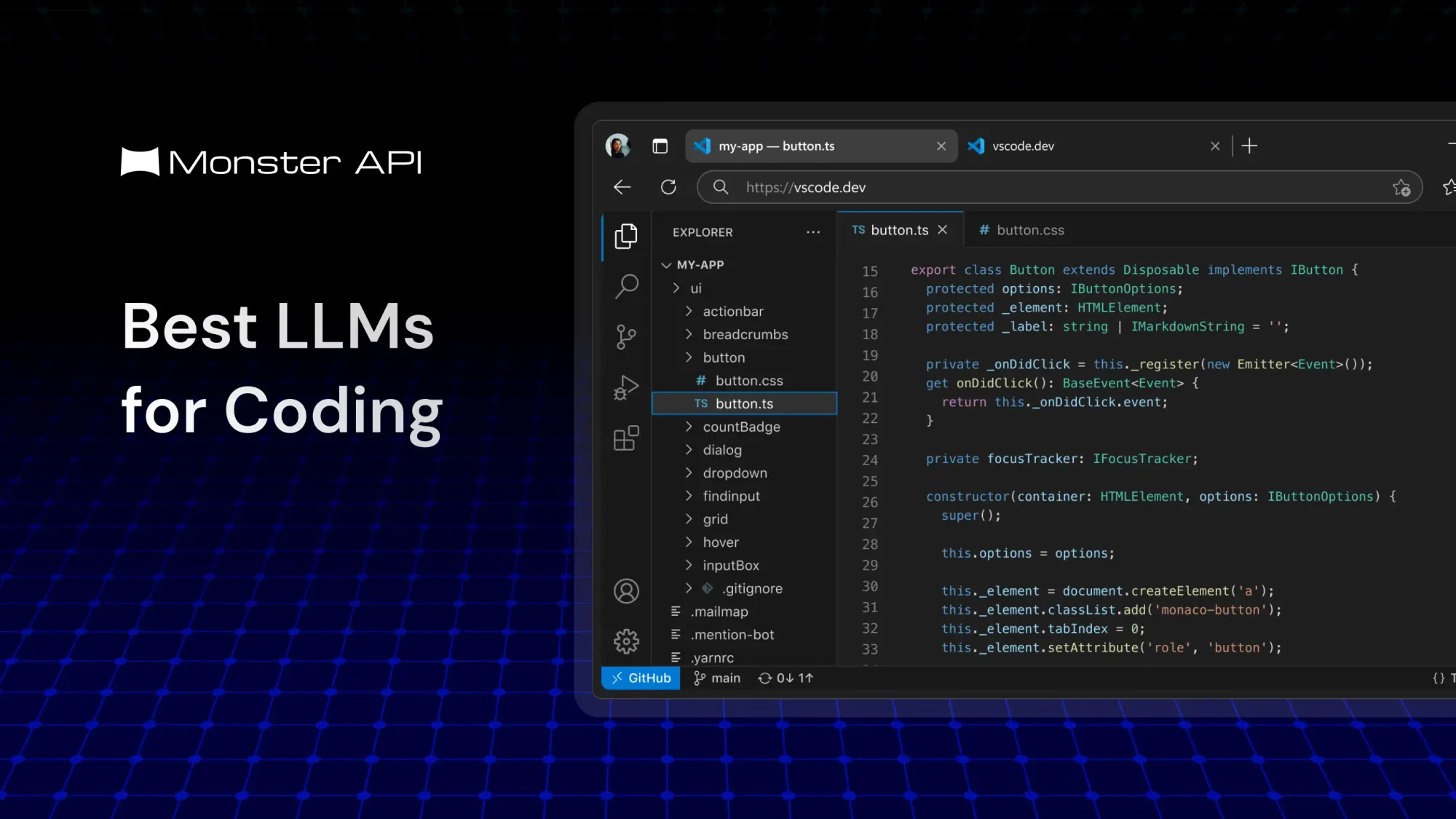The Best Large Language Models (LLMs) for Coding: A Comprehensive Guide
In this guide, we're covering all the best Large Language models you can use for code generation, their unique features, and how they boost productivity.

Developers are continuously on the lookout for tools and technologies that can enhance their workflow, speed up coding tasks, and reduce errors.
With the recent advancements in the Generative AI landscape, Large Language Models (LLMs) have emerged as powerful allies for software developers, fundamentally transforming the way we write and debug code.
While these AI assistants offer remarkable capabilities in code generation, refactoring, and problem-solving, their true potential lies in establishing an iterative dialogue with developers. The process often resembles a collaborative debugging session, where the initial code suggestion is just the beginning of a recursive refinement loop.
Despite their sophistication, LLMs rarely produce perfect code on the first attempt – instead, they excel as intelligent partners in an ongoing conversation of code improvement, error identification, and optimization.
In this guide, we’ll talk about some of the best LLMs for coding, their unique features, and how they can revolutionize your coding experience.
How Do Coding Assistants Work?
At their core, coding assistants powered by LLMs are designed to improve productivity and efficiency in software development. Here's how they generally function:
- Training Data: LLMs are trained on extensive datasets that consist of publicly available code repositories, technical documentation, and other relevant sources.
- Code Generation: When given a prompt or instruction, the LLM can generate code snippets, functions, or entire modules relevant to the context.
- Inline Suggestions: Many coding assistants can be integrated into popular Integrated Development Environments (IDEs) to provide real-time code suggestions as developers work.
- Debugging Assistance: LLMs can analyze existing code to identify potential errors, suggest fixes, and provide explanations for why certain solutions may work better.
- Dynamic Learning: Some LLMs can be fine-tuned with specific organizational data, allowing them to contextualize their advice according to the unique coding practices of a team or project.
Trust and Limitations
While LLMs represent a leap forward in coding assistance, developers should be cautious. Although they are increasingly proficient, they can still generate erroneous or misleading outputs, often referred to as "hallucinations." Therefore, validating output from LLMs before deploying it in production is crucial.
Top Large Language Models for Coding
In this section, we will explore the best LLMs currently available for coding, along with their unique advantages and disadvantages.
1. GPT-4o: A Strong Contender for Code Generation
When it comes to coding, GPT-4o has emerged as a reliable and cost-effective option for developers. Designed with a focus on efficiency, it offers robust code suggestions and excels in handling common programming tasks across various languages.
Its streamlined architecture allows for faster responses, making it ideal for developers looking for a coding assistant without the hefty price tag associated with more advanced models.
Comparing GPT-4o with GPT-o1
While GPT-4o performs well in code generation, GPT-o1 offers a more nuanced approach to complex tasks:
- Accuracy and Context Awareness: GPT-o1 outperforms GPT-4o in maintaining context over extended interactions, especially in multi-file projects. It’s more adept at generating detailed solutions for intricate coding challenges.
- Speed and Efficiency: GPT-4o delivers faster responses, making it more suitable for quick fixes and repetitive coding tasks, while GPT-o1 may take slightly longer due to its focus on precision.
- Cost Consideration: GPT-4o's lower cost makes it appealing for startups and individual developers, whereas GPT-o1 is better suited for enterprises requiring high-level accuracy.
In summary, GPT-4o is an excellent choice for routine coding needs, but developers tackling complex projects might prefer the enhanced depth offered by GPT-o1. Balancing speed, accuracy, and cost is key when choosing between the two.
2. Tabnine: AI-Powered Code Completion
Tabnine is known for its lightweight, AI-driven code completion tailored for developers seeking seamless integration with their IDEs. Its focus on privacy and offline capabilities makes it appealing to enterprises with stringent data security requirements.
Comparing Tabnine with GPT-4o
- Accuracy and Language Coverage: While Tabnine provides excellent language-specific support, it lacks the broad contextual awareness of GPT-4o, especially in multi-step reasoning tasks.
- Privacy and Self-Hosting: Unlike GPT-4o, Tabnine allows for local deployment, making it a top choice for companies prioritizing data control.
- Efficiency: Tabnine excels in speed but doesn’t offer the conversational depth or flexibility seen in GPT-4o for resolving complex issues.
3. Codeium: The Free Alternative for Developers
Codeium offers developers a no-cost solution for code suggestions and completion. It shines in its accessibility and fast integration into various environments, providing a solid option for those seeking functionality without subscription fees.
Comparing Codeium with GPT-4o
- Cost Advantage: Unlike GPT-4o, Codeium is entirely free, making it attractive for individual developers and small teams.
- Feature Depth: GPT-4o offers a richer set of features, including better handling of abstract problems and contextual prompts, whereas Codeium focuses more on code snippets and simple completions.
- Ease of Use: Codeium is easier to set up and use but lacks the nuanced capabilities GPT-4o provides in complex logic development.
4. Replit: Collaborative Code Generation and Hosting
Replit’s AI-powered code generation integrates directly into its cloud-based IDE, making it a standout tool for collaborative coding projects. Its focus on education and team projects distinguishes it from traditional LLMs.
Comparing Replit with GPT-4o
- Collaboration: Replit offers superior collaboration tools, allowing real-time co-development, which GPT-4o lacks.
- Code Hosting and Execution: Unlike GPT-4o, Replit enables instant code execution and hosting within its platform, which is valuable for rapid prototyping.
- LLM Performance: GPT-4o provides more sophisticated AI-driven suggestions compared to Replit’s simpler, context-aware completions.
5. Claude Sonnet 3.5: Advanced Contextual Reasoning
Claude Sonnet 3.5 from Anthropic emphasizes safety and long-context handling, making it ideal for projects requiring complex logic over extended interactions. Its ethical coding focus ensures safe and responsible AI assistance.
Comparing Claude Sonnet 3.5 with GPT-4o
- Context Length: Claude Sonnet 3.5 excels in maintaining context across longer interactions, surpassing GPT-4o in tasks involving complex multi-file projects.
- Ethical AI: Claude Sonnet's emphasis on safer AI responses differentiates it from GPT-4o, especially for enterprises concerned with code integrity and safety.
- Cost and Accessibility: GPT-4o remains a more budget-friendly option, while Claude Sonnet 3.5 appeals to those needing superior long-term contextual performance.
The Future of Large Language Models in Coding
As technology continues to advance rapidly, the landscape of LLMs for coding will likely evolve in tandem. Expect to see:
- Increased Accuracy: Future iterations of popular LLMs are expected to enhance basic language understanding significantly, reducing the frequency of coding errors.
- Broadened Language Support: We may anticipate LLMs that can not only understand newer programming languages as they come into play but can also adapt to emerging paradigms such as no-code and low-code frameworks.
- Personalized Learning: The potential for more personalized AI coding assistants that adapt to individual developer styles and preferences will make coding assistants even more valuable.
- Improved Collaboration Features: Future models are likely to emphasize collaborative tools that support remote work dynamics among teams.
Summing Up
In conclusion, choosing between these LLMs depends on specific needs—privacy, collaboration, cost, or advanced reasoning—ensuring there’s a suitable option for every developer.
MonsterAPI makes it easier for developers and enterprises to access these models with easy-to-use LLM AP Is. On MonsterAPI, you can get cost-effective and easy access to LLaMa 3.1 8B, Gemma 2 9B, and other models.
With ongoing advancements in AI, the coding future looks promisingly streamlined, making it essential for developers to stay informed about available tools and trends. Embrace the evolution—tap into the capabilities of LLMs, refine your coding skills, and embark on a journey toward more efficient coding practices.

